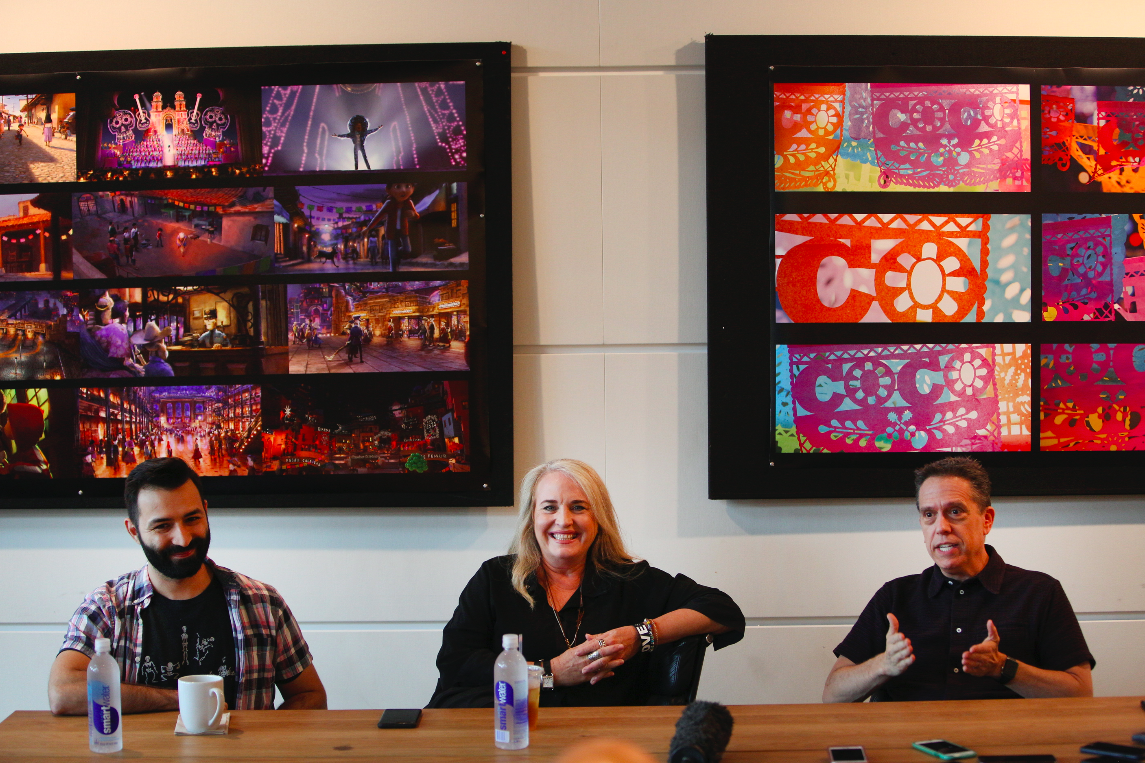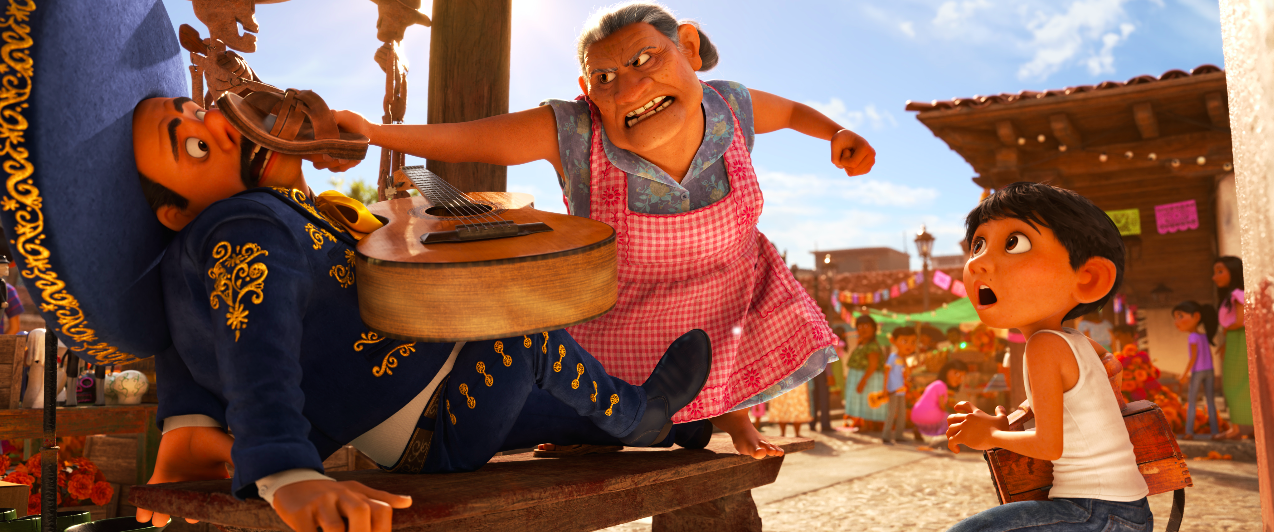As the next film from the esteemed and inimitable Pixar, Coco has all the makings of something huge. But as a film about Mexican culture, it also represents a potential minefield when it comes to the ways it represents people's very real cultural heritage and personal identities. Pixar has experience with films about other cultures, from Brave's portrayal of medieval Scotland to Ratatouille's setting in France. But centered as it is on a non-white and non-English speaking culture, Coco presented an even greater challenge. Luckily, the filmmakers were keen to do it right, as GameSpot learned on a recent press trip to Pixar's Emeryville, Calif. headquarters.
Set in a small town in Mexico, Coco follows a young boy named Miguel who longs to be a famous musician like his idol, the celebrated Ernesto De La Cruz. The movie takes place during Mexico's famous Dia de los Muertos--the Day of the Dead--celebration, the one day a year when passed family members are invited back to the land of the living. The movie's focus rests entirely on family, but there's the conflict, too: Miguel's family hates music and musicians. He practices on an acoustic guitar while cloistered in a hidden attic where nobody but his street dog amigo, Dante, can find him.
It's natural to feel wary when a gigantic company--even one with as phenomenal a reputation as Pixar--appears to seek to capitalize on another culture. The filmmakers confessed that they worked hard to navigate potential pitfalls.
"The moment [Pixar Chief Creative Office John Lasseter] said 'Yes, this is the idea I want you to pursue,' I went oh my gosh, what did I just get myself into? Because I knew that I had to get it right," said Coco Director Lee Unkrich, whose previous directing credits include Monsters, Inc., Finding Nemo, and Toy Story 2 and 3. "The last thing I wanted to do was make a film that felt like it was made by an outsider. I'm not Latino and I will never be Latino. I just can't change that. But I comforted myself in knowing that there have been a lot of great films made over time by filmmakers that were not of the cultures they were making films about."
He was first inspired to make a film centered on Dia de los Muertos by the Mexico pavilion in Disney's multi-cultural Epcot park in Florida. "I had always been drawn to Dia de los Muertos, the idea of the celebration, the folk art, the iconography of it," he told members of the press.
Plus, Pixar films are enormously successful in Mexico--prior to The Avengers, Toy Story 3 was the biggest movie ever in the country, Unkrich said. "That started the first little seed of me thinking, wow, I've never seen anything quite like that in animation, or live action," he said. "There hadn't been a film about Dia de los Muertos."
Once Lasseter approved it, they began an exhaustive years-long research process that would take them all over Mexico. "I started learning more about the celebration, and the beauty of it really opened up to me," Unkrich said. "It blossomed, and went beyond just an appreciation for the artwork to a much deeper understanding of what the celebration was really all about, and this whole notion of this family reunion that spans the divide between the living and the dead. And I just started to see a lot of potential for a story."

Unkrich isn't directing Coco alone. "When I heard that Coco got greenlit I was like 'put me on that movie. It sounds wonderful. It sounds beautiful,'" said Adrian Molina, the film's writer and co-director. Molina is of Mexican-American heritage, and he said he felt a huge responsibility to get this right.
"So much of the film is about family and your connection to family, and in my experience, in my upbringing, it's true of my Mexican-American community that that is very important," he said. "I think there's something really beautiful and necessary about being able to see yourself up on-screen, see yourself as the hero. And for a Mexican-American or a Mexican family to be able to go together and have that experience, I think that would be a unique thing that they could share in watching this film."
Coco sees Miguel travel from his hometown all the way to the Land of the Dead in pursuit of his dream. But despite its fantastical elements, everything is grounded in Miguel's desire not just to become a musician, but to be accepted by his family no matter what. He can't just run away with his guitar--that's what his great-great-grandfather did, and it caused his family seemingly irreparable harm. He has to prove himself to them, helping his family to see the joy of music as he does.
"We made some big changes in the story based on the input that we got from the advisers."
Miguel's unwavering dedication to his family is one of the aspects of Mexican culture that's central to Coco. That same accuracy and authenticity could be seen in every facet of the movie shown to press, from the movie's opening scenes to Miguel's foray into the Land of the Dead. Everything from the all-important music to the background art in every shot was painstakingly crafted by dedicated teams intent on creating a Mexican town that looks and sounds authentic. That attention to detail is a Pixar trademark, but in the case of Coco it can also be attributed to the cultural consultants with which the filmmakers worked at every step, beginning even earlier in the process than on most Pixar films.
"We did something that we've never done on any other film: We actually brought the core team of our cultural consultants, the three of them, we started inviting them to every one of our [internal] screenings," Unkrich said. "Normally at Pixar we play our cards really close, and it's not until very late in production that we start to do public preview screenings. But in this case we started showing the film not just to them, but we had a series of screenings where we brought in cultural advisers from Los Angeles and different places around the country, some pretty important figures in the Latino community, and let them into the tent, as it were, to see what we were up to."
"Some of them were very wary about what we were doing and not sure about what our intentions were and how seriously we were taking it, but I think we put them at ease pretty quickly--but also made them feel comfortable giving us sometimes big notes," he continued. "We made some big changes in the story based on the input that we got from the advisers."

For example, in earlier versions of Coco Miguel's Abuelita--his grandmother--carried a wooden spoon tucked in her apron strings, like a six-shooter, to whack people who made her angry. "It was one of our advisers who said, 'No no no no, it has to be her chancla,'" Unkrich said. "She's got to pull off her slipper and beat them with it." The film turned out better for it--Miguel's family are shoemakers, after all, and Abuelita's new weapon felt all at once truer to the character, more authentic, and funnier. Unkrich said that's just one of many examples where their work with cultural experts made the movie better.
It also doesn't hurt that every member of Coco's voice cast--with the sole exception of John Ratzenberger, who traditionally has had at least one line in every Pixar movie to date--is Latino. From Gael Garcia Bernal, who plays the wily skeleton Hector, to newcomer Anthony Gonzalez, who voices Miguel, each actor brought his or her own perspective and experience to the movie, according to the filmmakers.
"I have a little bit of Spanish as a second language, but my primary language is English, and so I'll write a line that expresses what we need to express, but then we also want to use our actors as a resource and say 'If you can say this line in a way that feels more natural to you and more natural to this character, by all means go for it,'" Molina said. "And Gael really went for it. He started keying onto things like, 'I want to call [Miguel] 'chamaco,' because that feels like an old-timey kind of way that this guy might relate to this kid.' And we're like, 'OK, do it. Go for it.'"
"If we have any missteps, it's not for lack of trying really hard."
Years of research and work on the part of countless individuals both inside and out of Pixar have gone into making Coco not just a great Pixar film--but a culturally respectful one, too. Ultimately, the filmmakers appreciate this responsibility, and they emphasized that they believe they've done their best.
"I took the responsibility very seriously, and I have for many, many years," Unkrich said. "It's been great having Adrian at my side, and all of the cultural consultants that we've gathered, and the many Latino members of our crew that have been a part of this for a long time. I hope we got it right. If we have any missteps, it's not for lack of trying really hard."
Based on what we've seen of Coco so far, it's a safe bet to say that their efforts paid off. The movie is now in theaters. For more, check out our Coco review.
